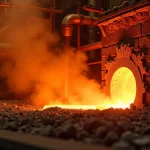High-temperature industrial processes demand materials that resist extreme heat, chemical attack, and mechanical wear. Refractory solutions provide this essential protection, ensuring equipment longevity and operational efficiency. By understanding their types, applications, and performance features—like thermal conductivity and shock resistance—industries can optimize processes from steelmaking to waste-to-energy, achieving durability and enhanced productivity in the harshest environments.
Clarifying High-Temperature Refractory Solutions for Industry Applications
on the Mxs-refractories website emphasizes the significance of high-performance refractory solutions tailored for demanding industrial processes. These high temperature insulation materials are critical in maintaining safety and operational efficiency across sectors such as steel, glass, and cement manufacturing.
Additional reading : Transform your space with expert floor cleaning services in surrey
Ceramic, silicon carbide, and other refractory bricks are renowned for their ability to withstand extreme heat and thermal shocks. Selecting the right high-temperature insulation ensures minimal energy loss and prolongs equipment lifespan. Saint-Gobain and Trent Refractories are among the industry leaders offering customized refractory designs—highlighted for their durability and resistance to chemical corrosion.
Effective furnace lining installation techniques and proper maintenance are essential to prevent wear and improve lifespan. These solutions, readily available via on the Mxs-refractories website, enhance process reliability in high-temperature environments, ensuring industries meet safety standards and optimize throughput. You can view more details on this page: on the Mxs-refractories website.
Also to read : Reliable electrician in croydon: 24/7 expert services
Types of Refractory Materials and Their Industrial Applications
Standard Fireclay and Alumina Bricks
Refractory bricks types and applications are most visible in the use of fireclay and alumina bricks, foundational materials in kiln lining installation techniques. These bricks excel in metallurgical furnace linings where sustained exposure to high temperatures and thermal cycling is common. The robust structure of these fire-resistant ceramics is designed for abrasion resistant linings and resistance to chemical corrosion in refractories, making them a mainstay in furnace maintenance best practices. Their role as thermal shock resistant materials means fewer repairs for kiln refractory replacement guidelines and reliable protection in steel industry heatproof materials.
Advanced Castable Refractories and Monolithics
Advances in castable refractory products have enabled more efficient refractory material installation standards. Solutions like self-flowing NORFLOW® eliminate the need for vibration, speeding up refractory bricks types and applications. These high durability ceramic linings, notable for energy-efficient heat containment and thermal conductivity reduction strategies, help manage expansion and contraction of refractory materials even during extreme process variations. High-performance refractory solutions providers now focus on custom refractory engineering services for specific requirements in thermal insulation engineering.
Ceramic Fiber and Insulating Firebricks
Ceramic fiber insulation and insulating firebricks properties deliver exceptional benefits in refractory bricks types and applications focused on ultralight, energy saving refractory technologies. These materials provide effective thermal insulation performance standards, important for furnace temperature control with insulation and durable kiln and furnace coatings in sectors like automotive and aerospace. Their contribution to refractory solution design and consulting revolves around efficient heat containment and improved process reliability.
Selection, Installation, and Maintenance of Refractory Systems
Precision in kiln lining installation techniques is central to the performance and reliability of high-temperature equipment. Selection starts with matching refractory bricks types and applications to operational requirements: temperature peaks, chemical exposure, physical stress, and regulatory standards for thermal insulation engineering. For glass furnaces or steelmaking, advanced thermal shock resistant materials and abrasion resistant linings are prioritized for enduring fluctuations and movement.
Installation techniques and surface finish demand careful attention. Modern kiln lining installation techniques use pre-cast components, self-flowing refractory mortar and castables, or ceramic fiber insulation for tight surfaces. A quality surface finish is necessary, particularly for automotive and aluminum manufacturing. Proper adherence to refractory material installation standards, layer thickness optimization, and joint sealing improve ceramic refractory performance and support longer service.
Repair and lifecycle management minimize disruptions. Scheduled maintenance focusing on high-wear sections of metallurgical furnace linings and incinerators, paired with rapid-response repair methods for refractory linings—like patching with high-temperature insulation materials or injecting refractory bonding agents—can significantly reduce downtime. Refractory solution lifecycle management leverages diagnostics, including refractory lining inspection techniques, wear monitoring, and stress evaluation, supporting cost-effective strategies and maximizing durability.
Industry-Specific Refractory Solutions and Case Examples
Refractory solutions for cement industry are engineered to address aggressive chemical attack and significant thermal shock within rotary kilns and preheater systems. Custom kiln lining installation techniques, featuring abrasion resistant linings and high temperature insulation materials, support operational longevity and minimize shutdowns. Saint-Gobain and Trent Refractories have implemented refractory bricks types and applications that tolerate the frequent expansion and contraction of refractory materials in cement plants, combining durable kiln and furnace coatings with reliable refractory mortar and castables.
For refractory materials for glass manufacturing, precision is paramount. Glass furnaces require refractory materials for glass manufacturing that withstand extreme thermal protection in glass furnaces and cycles of high thermal gradients. Ceramic fiber insulation and insulating firebricks properties help deliver energy-efficient heat containment, reducing fuel costs while maintaining glass quality. Providers, such as Saint-Gobain, actively refine fire-resistant ceramics and thermal insulation engineering, optimizing compositions for both corrosion and erosion resistant refractory materials.
Refractory solutions in waste-to-energy plants must endure corrosive fumes, mechanical wear, and relentless temperature swings. Specialized refractory linings for boilers and refractory solutions for incinerators utilize advanced abrasion resistant linings and corrosion resistant refractory materials to safeguard structural integrity. High-performance refractory solutions providers focus on refractory coatings for metal smelting and process-specific refractory materials for power plants, prioritizing lifecycle cost analysis and thermal stability in harsh environments.
Advanced Solutions for High-Temperature Industrial Processes
Precision in metallurgical furnace linings and kiln lining installation techniques is vital for both efficiency and longevity. Using the Stanford Question Answering Dataset (SQuAD) method, here’s a precise response: thermal shock resistant materials and refractory bricks types and applications remain at the core of reliable, energy-efficient heat containment in harsh environments.
High temperature insulation materials, such as ceramic fiber insulation and insulating firebricks properties, are engineered to deliver superior performance where furnace temperature control with insulation is required. These solutions address demanding conditions by ensuring resistance to chemical corrosion in refractories and improving expansion and contraction of refractory materials, which enhances overall safety and structural stability.
Castable refractory products and refractory mortar and castables provide flexibility during installation and maintenance. When repair methods for refractory linings are needed, abrasion resistant linings and repair products support quick turnaround while minimizing operational downtime.
Energy saving refractory technologies and refractory solution optimization methods underscore the industry’s commitment to cost-effective, sustainable refractory materials development. Thermal insulation engineering, stress resistance, and kiln refractory replacement guidelines form the basis for continuous innovation—ensuring that industrial heat resistance coatings, refractory materials for glass manufacturing, and refractory linings for petrochemical processing all deliver on durability, efficiency, and protection.











